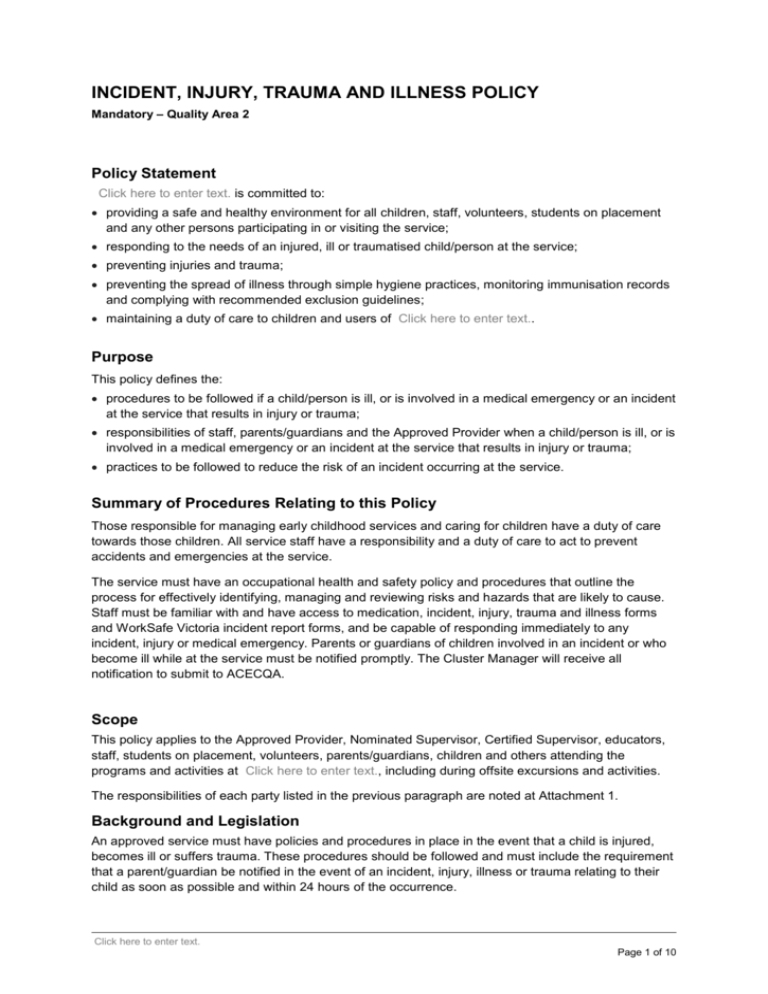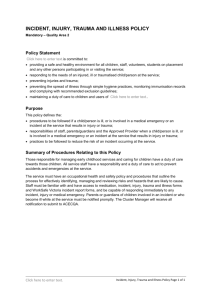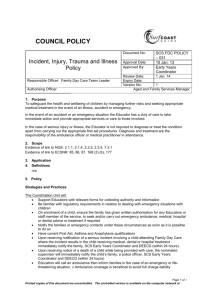Incident Injury Trauma and Illness Policy website
advertisement

INCIDENT, INJURY, TRAUMA AND ILLNESS POLICY Mandatory – Quality Area 2 Policy Statement Click here to enter text. is committed to: providing a safe and healthy environment for all children, staff, volunteers, students on placement and any other persons participating in or visiting the service; responding to the needs of an injured, ill or traumatised child/person at the service; preventing injuries and trauma; preventing the spread of illness through simple hygiene practices, monitoring immunisation records and complying with recommended exclusion guidelines; maintaining a duty of care to children and users of Click here to enter text.. Purpose This policy defines the: procedures to be followed if a child/person is ill, or is involved in a medical emergency or an incident at the service that results in injury or trauma; responsibilities of staff, parents/guardians and the Approved Provider when a child/person is ill, or is involved in a medical emergency or an incident at the service that results in injury or trauma; practices to be followed to reduce the risk of an incident occurring at the service. Summary of Procedures Relating to this Policy Those responsible for managing early childhood services and caring for children have a duty of care towards those children. All service staff have a responsibility and a duty of care to act to prevent accidents and emergencies at the service. The service must have an occupational health and safety policy and procedures that outline the process for effectively identifying, managing and reviewing risks and hazards that are likely to cause. Staff must be familiar with and have access to medication, incident, injury, trauma and illness forms and WorkSafe Victoria incident report forms, and be capable of responding immediately to any incident, injury or medical emergency. Parents or guardians of children involved in an incident or who become ill while at the service must be notified promptly. The Cluster Manager will receive all notification to submit to ACECQA. Scope This policy applies to the Approved Provider, Nominated Supervisor, Certified Supervisor, educators, staff, students on placement, volunteers, parents/guardians, children and others attending the programs and activities at Click here to enter text., including during offsite excursions and activities. The responsibilities of each party listed in the previous paragraph are noted at Attachment 1. Background and Legislation An approved service must have policies and procedures in place in the event that a child is injured, becomes ill or suffers trauma. These procedures should be followed and must include the requirement that a parent/guardian be notified in the event of an incident, injury, illness or trauma relating to their child as soon as possible and within 24 hours of the occurrence. Click here to enter text. Page 1 of 10 The National Regulations require an accurate Incident, Injury, Trauma and Illness Record to be kept and stored confidentially until the child is 25 years old (Regulation 183(2)). Under the national legislation, each service must ensure that an entry is recorded in the Incident, Injury, Trauma and Illness Record for the following occurrences: an incident in relation to a child, an injury received by a child or trauma to which a child has been subjected; an illness that becomes apparent. Details that must be entered in the Incident, Injury, Trauma and Illness Record include the following: the name and age of the child the circumstances leading to the incident, injury or trauma, or relevant circumstances surrounding the child becoming ill (including any symptoms) the time and date the incident occurred, the injury was received or the child was subjected to the trauma, or the apparent onset of the illness the action taken by the service, including any medication administered, first aid provided or medical personnel contacted details of any person who witnessed the incident, injury or trauma, or the apparent onset of illness the name of any person the service notified, or attempted to notify, of any incident, injury, trauma or illness that a child suffered while being educated and cared for by the service, and the time and date of the notifications/attempted notifications the name and signature of the person making an entry in the record, and the time and date that the entry was made signature of a parent/guardian to verify that they have been informed of the occurrence. All information will be included in the Incident, Injury, Trauma and Illness Record as soon as is practicable, but not later than 24 hours after the incident, injury or trauma, or the onset of the illness. Medical emergencies may include serious health issues such as asthma, anaphylaxis, diabetes, fractures, choking and seizures. Such emergencies generally involve only one child, however they can affect everyone in the children’s service. In some cases it will be appropriate to refer to specific policies for guidance, such as the Dealing with Medical Conditions Policy, Asthma Policy and Anaphylaxis Policy. Attachment 2 contains a list of the legislation and sources relevant to this policy, including Acts and Regulations. Evaluation In order to assess whether the goals and purposes of this policy have been achieved, the Approved Provider of Click here to enter text. will: regularly seek feedback from everyone affected by the policy regarding its effectiveness; monitor the implementation, compliance, complaints and incidents in relation to this policy; review and analyse information gathered from the Incident, Injury, Trauma and Illness Record and staff first aid records regarding incidents at the service; keep the policy up to date with current legislation, research, policy and best practice; revise the policy and procedures as part of the service’s policy review cycle, or as required; notify parents/guardians at least 14 days before making any changes to this policy or its procedures; Review SafeCare Guide 2012 (UCVT) on a regular basis. Hold regular reference meetings of agencies using the UCVT SafeCare Guide. Click here to enter text. Incident, Injury, Trauma and Illness Policy Page 2 of 10 Definitions The terms defined in this section relate specifically to this policy. For commonly used terms e.g. Approved Provider, Nominated Supervisor, Regulatory Authority etc. refer to the General Definitions section of this manual. AV How to Call Card: A card that the service has completed containing all the information that Ambulance Victoria will request when phoned. A sample card can be downloaded from www.ambulance.vic.gov.au/Education/Calling-Triple-0.html Emergency services: Includes ambulance, fire brigade, police and state emergency services. First aid: The provision of initial care in response to an illness or injury. It generally consists of a series of techniques to preserve life, protect a person (particularly if unconscious), prevent a condition worsening and promote recovery. First aid training should be delivered by approved first aid providers, and a list is published on the ACECQA website: www.acecqa.gov.au/educators-and-providers1/ qualifications Hazard: A source or situation with a potential for harm in terms of human injury or ill health, damage to property, damage to the environment or a combination of these. Incident: Any unplanned event resulting in or having potential for injury, ill health, damage or other loss. Injury: Any physical damage to the body caused by violence or an incident. Medication: Any substance, as defined in the Therapeutic Goods Act 1989 (Cth), that is administered for the treatment of an illness or medical condition. Medical management plan: A document that has been prepared and signed by a doctor that describes symptoms, causes, clear instructions on action and treatment for the child’s specific medical condition, and includes the child’s name and a photograph of the child. An example of this is the Australasian Society of Clinical Immunology and Allergy (ASCIA) Action Plan. Medical attention: Includes a visit to a registered medical practitioner or attendance at a hospital. Medical emergency: An injury or illness that is acute and poses an immediate risk to a person's life or long-term health. Minor incident: An incident that results in an injury that is small and does not require medical attention. Notifiable incident: An incident involving workplace health and safety that is required by law to be reported to WorkSafe Victoria. Notification is required for incidents that result in death or serious injury/illness, or dangerous occurrences. For a complete list of incidents that must be reported to WorkSafe Victoria, refer to the Guide to Incident Notification on the WorkSafe Victoria website: www.worksafe.vic.gov.au Serious incident: An incident resulting in the death of a child, or an injury, trauma or illness for which the attention of a registered medical practitioner, emergency services or hospital is sought or should have been sought. This also includes an incident in which a child appears to be missing, cannot be accounted for, is removed from the service in contravention of the regulations or is mistakenly locked in/out of the service premises (Regulation 12). A serious incident should be documented in an Incident, Injury, Trauma and Illness Record (sample form available on the ACECQA website) as soon as possible and within 24 hours of the incident. The Regulatory Authority (ACECQA) must be notified within 24 hours of a serious incident occurring at the service (Regulation 176(2)(a)). Records are required to be retained for the periods specified in Regulation 183. Trauma: An emotional wound or shock that often has long-lasting effects or any physical damage to the body caused by violence or an incident. Click here to enter text. Incident, Injury, Trauma and Illness Policy Page 3 of 10 Authorisation This policy was adopted by Click here to enter text. on Click here to enter text.. Review date: CLICK HERE TO ENTER TEXT. This policy should be read in conjunction with: Administration of Medication Policy Anaphylaxis Policy Asthma Policy Emergency and Evacuation Policy Excursions and Service Events Policy Administration of First Aid Policy Dealing with Infectious Diseases Policy Occupational Health and Safety Policy Privacy and Confidentiality Policy Click here to enter text. Incident, Injury, Trauma and Illness Policy Page 4 of 10 Attachment 1: Responsibilities relating to the Incident, Injury, Trauma and Illness Policy Action Approved Provider Ensure the premises are kept clean and in good repair x Ensure that staff have access to medication, incident, injury, trauma and illness forms and WorkSafe Victoria incident report forms Ensure the service has an occupational health and safety policy and procedures that outline the process for effectively identifying, managing and reviewing risks and hazards that are likely to cause injury, and reporting notifiable incidents to appropriate authorities (see Occupational Health and Safety Policy) x Ensure that completed medication records are kept until the end of 3 years after the child’s last attendance (Regs. 92, 183) x Ensure that a parent/guardian of the child is notified as soon as is practicable, but not later than 24 hours after the occurrence, if the child is involved in any incident, injury, trauma or illness while at the service (Reg. 86) x Ensure that incident, injury, trauma and illness records 1 are kept and stored securely until the child is 25 years old (Regs. 87, 183) x Ensure that there is a minimum of one educator with a current approved first aid qualification on the premises at all times x Ensure that there are an appropriate number of up-todate, fully equipped first aid kits that are accessible at all times x Ensure that the orientation and induction of new and relief staff include an overview of their responsibilities in the event of an incident or medical emergency x Ensure that children’s enrolment forms provide authorisation for the service to seek emergency medical treatment by a medical practitioner, hospital or ambulance service x Ensure that an incident report (SI01) is completed and registered on-line with ACECQA as soon as is practicable but no later than 24 hours after the occurrence of an incident. x Ensure that the following are displayed near all telephones: Nom’ed S’visor Cert’ed S’visor Educators x x Parents/ Guardians x 000 and AV How to Call Card DEECD regional office 1 For a template Incident, Injury, Trauma and Illness Record, visit the ACECQA website: www.acecqa.gov.au/resources-and-templates/ Click here to enter text. Attachment 1: Responsibilities relating to the Incident, Injury, Trauma and Illness Policy Page 5 of 10 Nom’ed S’visor Cert’ed S’visor Educators Ensure that volunteers and parents on duty are aware of children’s medical management plans and their responsibilities in the event of an incident, injury or medical emergency x x Respond immediately to any incident, injury or medical emergency x x Implement individual children’s medical management plans, where relevant x x Notify parents/guardians immediately after an incident, injury, trauma or medical emergency, or as soon as is practicable x x Request that parents/guardians make arrangements for the child or children involved in an incident or medical emergency to be collected from the service, or informing parents/guardians if an ambulance has been called x Notify other person/s as authorised on the child’s enrolment form when the parents/guardians are not contactable x x Record details of any incident, injury or illness in the Incident, Injury, Trauma and Illness Record as soon as is practicable but not later than 24 hours after the occurrence x x Ensure that regulatory and legislative responsibilities are met in relation to any incident, injury or medical emergency x x Maintain all enrolment and other medical records in line with the Privacy and Confidentiality Policy x x Regularly check equipment in both indoor and outdoor areas for hazards, and take the appropriate action to ensure the safety of the children when a hazard is identified. (See SafeCare Guide forms) x x Assist the Approved Provider with regular hazard inspections (refer to SafeCare guide checklists) x x Review the cause of any incident, injury or illness and take appropriate action to remove the cause if required x x Notify ACECQA in writing within 24 hours of an incident involving the death of a child, or any incident, illness or trauma that requires treatment by a registered medical practitioner or admission to a hospital x x Action Approved Provider Parents/ Guardians Approved Provider Asthma Victoria: (03) 9326 7055 or toll free 1800 645 130 Victoria Poisons Information Centre: 13 11 26 local council or shire Click here to enter text. Attachment 1: Responsibilities relating to the Incident, Injury, Trauma and Illness Policy Page 6 of 10 Action Approved Provider Nom’ed S’visor Cert’ed S’visor In a medical emergency (see Definitions): Educators Parents/ Guardians x call an ambulance, where necessary administer first aid, and provide care and comfort to the child prior to the parents/guardians or ambulance arriving implement the child’s current medical management plan, where appropriate notify parents/guardians as soon as is practicable of any serious medical emergency, incident or injury concerning the child, and request the parents/guardians make arrangements for the child to be collected from the service and/or inform the parents/guardians that an ambulance has been called notify other person/s as authorised on the child’s enrolment form, if the parents/guardians are not contactable ensure ongoing supervision of all children in attendance at the service accompany the child in the ambulance when the parents/guardians are not present, provided that staff-to-child ratios can be maintained at the service notify the Approved Provider of the medical emergency, incident or injury as soon as is practicable complete and submit an incident report to DEECD, the Approved Provider and the service’s public liability insurer following a serious incident When a child develops symptoms of illness: x ensure that the Nominated Supervisor, or person in day-to-day care of the service, contacts the parents/guardians or authorised emergency contact for the child to outline the signs and symptoms observed request that the child is collected from the service if the child is not well enough to participate in the program ensure that they separate the child from the group and have a staff member remain with the child until the child recovers, a parent/guardian arrives or another responsible person takes charge call an ambulance if a child appears very unwell or has a serious injury that needs urgent medical attention ensure that the child is returned to the care of the parent/guardian or authorised emergency contact person as soon as is practicable ensure that, where medication, medical or dental treatment is obtained, the parents/guardians are notified as soon as is practicable and within 24 hours, and are provided with details of the illness and subsequent treatment administered to the child ensure that the Approved Provider is notified of the incident ensure that the Incident, Injury, Trauma and Illness Record is completed as soon as is practicable and within 24 hours of the occurrence Provide authorisation in your child’s enrolment record for the service to seek emergency medical treatment by a medical practitioner, hospital or ambulance service (Regulation 161(1)) x Pay all costs incurred when an ambulance service is called to attend to their child at the service x Click here to enter text. Attachment 1: Responsibilities relating to the Incident, Injury, Trauma and Illness Policy Page 7 of 10 Action Approved Provider Nom’ed S’visor Cert’ed S’visor Educators Parents/ Guardians Notify the service, upon enrolment or diagnosis, of any medical conditions and/or needs, and any management procedure to be followed with respect to that condition or need (Reg. 162) x Ensure you provide the service with a current medical management plan for your child, if applicable (Reg 162(d)) x Collect your child as soon as possible when notified of an incident, injury or medical emergency involving the child x Inform the service of an infectious disease or illness that has been identified while the child has not attended the service, and that may impact on the health and wellbeing of other children, staff and parents/guardians attending the service x Be contactable, either directly or through emergency contacts listed on the child’s enrolment form, in the event of an incident requiring medical attention x Sign the Incident, Injury, Trauma and Illness Record, thereby acknowledging that you have been made aware of the incident x Notify the service by telephone if your child will be absent from their regular program x Notify staff/educators if there is a change in the condition of your child’s health, or if there have been any recent accidents or incidents that may impact on the child’s care e.g. any bruising or head injuries x Note: Volunteers and students, while at the service, are responsible for following this policy and its procedures. Click here to enter text. Attachment 1: Responsibilities relating to the Incident, Injury, Trauma and Illness Policy Page 8 of 10 ATTACHMENT 2: LEGISLATION AND SOURCES Legislation and standards Relevant legislation and standards include but are not limited to: Education and Care Services National Law Act 2010: Section 174(2) Education and Care Services National Regulations 2011: Regulations 77, 85–87, 103, 177, 183 Public Health and Wellbeing Act 2008 (Vic) Public Health and Wellbeing Regulations 2009 (Vic) Occupational Health and Safety Act 2004 (Vic), as amended 2007 Occupational Health and Safety Regulations 2007 WorkSafe Victoria Compliance Code: First aid in the workplace (2008) Australian Standards AS3745–2002, Emergency control procedures for buildings, structures and workplaces National Quality Standard, Quality Area 2: Children’s Health and Safety Standard 2.1: Each child’s health is promoted Element 2.1.1: Each child’s health needs are supported Element 2.1.3: Effective hygiene practices are promoted and implemented Element 2.1.4: Steps are taken to control the spread of infectious diseases and to manage injuries and illness, in accordance with recognised guidelines National Quality Standard, Quality Area 3: Physical Environment Standard 3.1: The design and location of the premises is appropriate for the operation of a service Element 3.1.2: Premises, furniture and equipment are safe, clean and well maintained National Quality Standard, Quality Area 7: Leadership and Service Management Standard 7.3: Administrative systems enable the effective management of a quality service Element 7.3.1: Records and information are stored appropriately to ensure confidentiality, are available from the service and are maintained in accordance with legislative requirements Element 7.3.2: Administrative systems are established and maintained to ensure effective operation of the service Sources VMIA Insurance Guide, Community Service Organisations program: www.vmia.vic.gov.au/Insurance/Policies-and-Manuals/Community-Service-OrganisationsProgram.aspx Building Code of Australia National Health and Medical Research Council (2005), Staying Healthy in Child Care: Preventing infectious diseases in child care, available at www.nhmrc.gov.au/guidelines/publications/ch55 or email nhmrc.publications@nhmrc.gov.au. (Note: this publication is currently being revised and will have significant changes. It is important that services refer to the most up-to-date version of this resource.) WorkSafe Victoria: Guide to Incident Notification Ambulance Victoria: AV How to Call Card SafeCare Guide (UCVT) 2012 Click here to enter text. Attachment 1: Responsibilities relating to the Incident, Injury, Trauma and Illness Policy Page 9 of 10 ATTACHMENT 3 Samples of these documents can be found on the UCVT Early Childhood Services website. SafeSearch Daily SafeSearch Monthly Click here to enter text. Attachment 1: Responsibilities relating to the Incident, Injury, Trauma and Illness Policy Page 10 of 10









